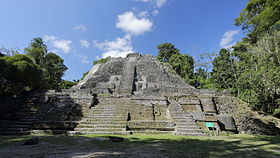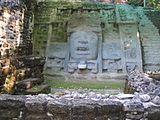
Altun Ha is the name given to the ruins of an ancient Maya city in Belize, located in the Belize District about 50 kilometres (31 mi) north of Belize City and about 10 kilometres (6.2 mi) west of the shore of the Caribbean Sea. The site covers an area of about 8 square kilometres (3.1 sq mi).
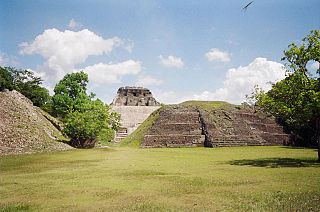
The Maya ruins of Belize include a number of well-known and historically important pre-Columbian Maya archaeological sites. Belize is considered part of the southern Maya lowlands of the Mesoamerican culture area, and the sites found there were occupied from the Preclassic until and after the arrival of the Spanish in the 16th century.
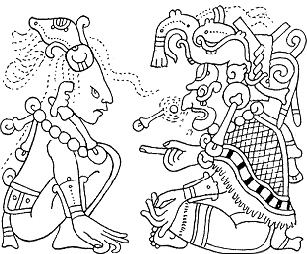
Sacrifice was a religious activity in Maya culture, involving the killing of humans or animals, or bloodletting by members of the community, in rituals superintended by priests. Sacrifice has been a feature of almost all pre-modern societies at some stage of their development and for broadly the same reason: to propitiate or fulfill a perceived obligation towards the gods.

The emergence of metallurgy in pre-Columbian Mesoamerica occurred relatively late in the region's history, with distinctive works of metal apparent in West Mexico by roughly 800 CE, and perhaps as early as 600 CE. Metallurgical techniques likely diffused northward from regions in Central or South America via maritime trade routes; recipients of these metallurgical technologies apparently exploited a wide range of material, including alloys of copper-silver, copper-arsenic, copper-tin and copper-arsenic-tin.

Cerros is an Eastern Lowland Maya archaeological site in northern Belize that functioned from the Late Preclassic to the Postclassic period. The site reached its apogee during the Mesoamerican Late Preclassic and at its peak, it held a population of approximately 1,089 people. The site is strategically located on a peninsula at the mouth of the New River where it empties into Chetumal Bay on the Caribbean coast. As such, the site had access to and served as an intermediary link between the coastal trade route that circumnavigated the Yucatán Peninsula and inland communities. The inhabitants of Cerros constructed an extensive canal system and utilized raised-field agriculture.

Tazumal is a pre-Columbian archeological site in Chalchuapa, El Salvador. Tazumal is an architectural complex within the larger area of the ancient Mesoamerican city of Chalchuapa, in western El Salvador. The Tazumal group is located in the southern portion of the Chalchuapa archaeological zone. Archaeologist Stanley Boggs excavated and restored the Tazumal complex during the 1940s and 1950s.
Ancient Maya art comprises the visual arts of the Maya civilization, an eastern and south-eastern Mesoamerican culture made up of a great number of small kingdoms in present-day Mexico, Guatemala, Belize and Honduras. Many regional artistic traditions existed side by side, usually coinciding with the changing boundaries of Maya polities. This civilization took shape in the course of the later Preclassic Period, when the first cities and monumental architecture started to develop and the hieroglyphic script came into being. Its greatest artistic flowering occurred during the seven centuries of the Classic Period.
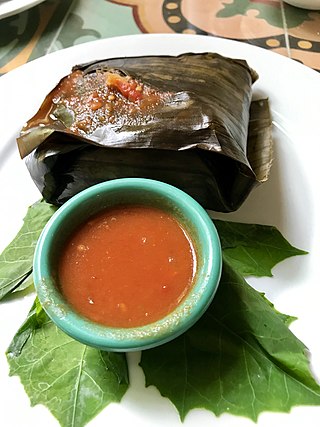
Ancient Maya cuisine was varied and extensive. Many different types of resources were consumed, including maritime, flora, and faunal material, and food was obtained or produced through strategies such as hunting, foraging, and large-scale agricultural production. Plant domestication concentrated upon several core foods, the most important of which was maize.

The Museo Popol Vuh is home to one of the major collections of Maya art in the world. It is located on the campus of the Universidad Francisco Marroquín in Zone 10, Guatemala City. The museum is known for its extensive collection of pre-Columbian and colonial art of the Maya culture.

The Huastec civilization was a pre-Columbian civilization of Mesoamerica, occupying a territory on the Gulf coast of Mexico that included the northern portion of Veracruz state, and neighbouring regions of the states of Hidalgo, Querétaro, San Luis Potosí, and Tamaulipas. The Huastec people were an early offshoot of the Maya peoples that migrated northwards.

The Maya civilization was a Mesoamerican civilization that existed from antiquity to the early modern period. It is known by its ancient temples and glyphs (script). The Maya script is the most sophisticated and highly developed writing system in the pre-Columbian Americas. The civilization is also noted for its art, architecture, mathematics, calendar, and astronomical system.

The Pre-Columbian Belize history is the period from initial indigenous presence, across millennia, to the first contacts with Europeans - the Pre-Columbian or before Columbus period - that occurred on the region of the Yucatán Peninsula that is present day Belize.
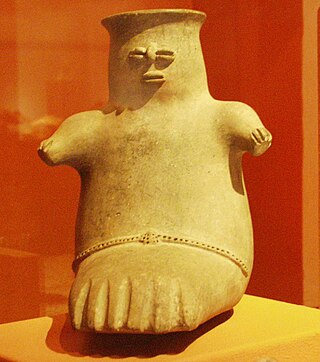
Chupícuaro is an important prehispanic archeological site from the late preclassical or formative period. The culture that takes its name from the site dates to 400 BC to 200 AD, or alternatively 500 BC to 300 AD., although some academics suggest an origin as early as 800 BC.

Santa Rita is a Maya ruin and an archaeological reserve on the outskirts of Corozal, Belize. Historical evidence suggests that it was probably the ancient and important Maya city known as Chetumal.
David Michael Pendergast, is an American archaeologist, and is most famous for his work at Altun Ha and Lamanai, Belize. He received a Bachelor of Arts in Anthropology in 1955 from the University of California, Berkeley, and earned his Ph.D. in 1961 at the University of California, Los Angeles, studying with Clement Meighan. He was later married to Elizabeth Graham, also a Mesoamerican Archaeologist.

Pacbitun is a Maya archaeological site located near the town of San Ignacio, Belize, in the Cayo District of west central Belize. The modern Maya name given to the site means “stone set in earth”, likely a reference to multiple fragments of stone monuments. The site, at about 240 m above sea level, is one of the earliest known from the southern Maya Lowlands, and was inhabited for almost 2000 years, from ca. 900 BCE to 900 CE. Strategically, it straddles a territory of rolling, hilly terrain between the Mountain Pine Ridge and the tropical forest covered lowlands of the Upper Belize River Valley.

The extensive trade networks of the Ancient Maya contributed largely to the success of their civilization spanning three millennia. Maya royal control and the wide distribution of foreign and domestic commodities for both population sustenance and social affluence are hallmarks of the Maya visible throughout much of the iconography found in the archaeological record. In particular, moderately long-distance trade of foreign commodities from the Caribbean and Gulf Coasts provided the larger inland Maya cities with the resources they needed to sustain settled population levels in the several thousands. Though the ruling class essentially controlled the trade economy, a middle merchant class supervised import and export from cities and trade ports. Not much is known of the Maya merchant class; however, merchants of royal lineage are sometimes represented in the iconography. Notably, a canoe paddle often accompanies the royal merchant depictions, signifying their association with marine resources.
Elizabeth Graham is a professor of Mesoamerican Archaeology at UCL. She has worked, for decades, on the Maya civilization, both in prehispanic and colonial times, specifically in Belize. She has recently turned her attention to Maya Dark Earths, and conducts pioneering work in the maya region as dark earths have mostly been studied in the Amazonia. She particularly focuses on how human occupation influences soil formation and production.

The Preclassic or Formative Period of Belizean, Maya, and Mesoamerican history began with the Maya development of ceramics during 2000 BC – 900 BC, and ended with the advent of Mayan monumental inscriptions in 250 AD.

The periodisation of the history of Belize is the division of Belizean, Maya, and Mesoamerican history into named blocks of time, spanning the arrival of Palaeoindians to the present time. The pre-Columbian era is most often periodised by Mayanists, who often employ four or five periods to discuss history prior to the arrival of Spaniards. The Columbian era is most often periodised by historians, and less often by Mayanists, who often employ at least four periods to discuss history up to the present time.
